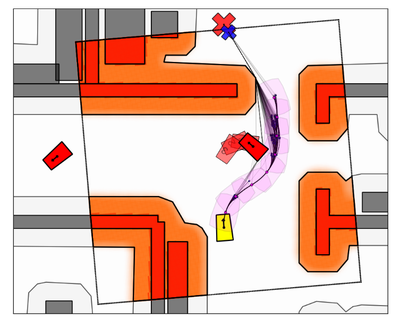Fast-Replanning Motion Control for Non-Holonomic Vehicles with Aborted A*
Authors:
M. Missura, A. Roychoudhury, M. BennewitzType:
Conference ProceedingPublished in:
IEEE/RSJ International Conference on Intelligent Robots and Systems (IROS)Year:
2022Links:
BibTex String
@InProceedings{Missura22iros,
author = {M. Missura and A. Roychoudhury and M. Bennewitz},
title = {Fast-Replanning Motion Control for Non-Holonomic Vehicles Using Aborted {A}*},
booktitle = {Proc.~of the IEEE/RSJ International Conference on Intelligent Robots and Systems (IROS)},
year = 2022
}

Abstract:
Autonomously driving vehicles must be able to navigate in dynamic and unpredictable environments in a collision-free manner. So far, this has only been partially achieved in driverless cars and warehouse installations where marked structures such as roads, lanes, and traffic signs simplify the motion planning and collision avoidance problem. We are presenting a new control approach for car-like vehicles that is based on an unprecedentedly fast-paced A* implementation that allows the control cycle to run at a frequency of 30 Hz. This frequency enables us to place our A* algorithm as a low-level replanning controller that is well suited for navigation and collision avoidance in virtually any dynamic environment. Due to an efficient heuristic consisting of rotate-translate-rotate motions laid out along the shortest path to the target, our Short-Term Aborting A* (STAA*) converges fast and can be aborted early in order to guarantee a high and steady control rate. While our STAA* expands states along the shortest path, it takes care of collision checking with the environment including predicted states of moving obstacles, and returns the best solution found when the computation time runs out. Despite the bounded computation time, our STAA* does not get trapped in corners due to the following of the shortest path. In simulated and real-robot experiments, we demonstrate that our control approach eliminates collisions almost entirely and is superior to an improved version of the Dynamic Window Approach with predictive collision avoidance capabilities.

